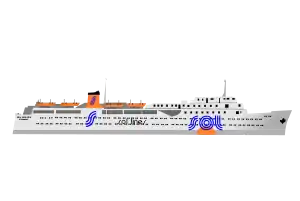 Sol Phryne with Sol Maritime Services markings[1] | |
| History | |
|---|---|
| Name |
|
| Builder | Mitsubishi Jukogyo, Kobe, Japan |
| Launched | 1948 |
| Completed | October 1948 |
| Fate | Crippled by a limpet mine on 16 February 1988 |
| General characteristics | |
| Type | Ferry |
| Displacement | 6150 tonnes. |
| Length | 118.7 m (389 ft) |
| Beam | 15.9 m (52 ft) |
| Speed | 15.5 knots (28.7 km/h; 17.8 mph) |
| Capacity | 630 passengers |
Sol Phryne was a ferry of Sol Maritime Services Ltd. She was bought by the Palestine Liberation Organisation and sunk on 16 February 1988.
Sol Phryne was built in Japan in 1948 as Taisetsu Maru (大雪丸).
From 1967 to 1974, she was owned by Efthymiades Line and used for regular ferry duties between Greek islands as Eolis. In 1974, she was purchased by Sol Maritime Services Ltd., renamed Sol Phryne and was then used in the Middle East, notably evacuating Palestinian guerrillas from Beirut in 1982. She was sunk during an attempt to ferry Palestinian deportees to Haifa, Israel.
Voyage
The 6,151-ton Sol Phryne was purchased in some secrecy by the Palestine Liberation Organization and renamed Al Awda ("the Return"). The PLO planned to symbolically ferry 135 Palestinian deportees and, if they accepted the short notice invitation, hundreds of journalists and other observers, to the Israeli port city of Haifa for a "journey of return", echoing the 1947 journey of SS Exodus.[2][3]
Israeli Defence Minister Yitzhak Rabin stated that Israel would oppose the voyage "in whatever ways we find,"[3] while Prime Minister Yitzhak Shamir labeled the journey "a declaration of war".[4]
A different, chartered ship had been scheduled to sail from Piraeus on 9 February, but the departure was postponed several times because Greek ship owners feared commercial retaliations from Israel if their vessel was used.[3] With this difficulty chartering a ship, on 13 February 1988 the PLO purchased the Sol Phryne in Limassol, Cyprus at auction for $600,000. By the time of the sinking the crew of the ship had not been informed of the new owners.
On 15 February, three high-ranking military officials of the PLO were assassinated in Limassol by a remote-controlled bomb planted on their car.[5]
18 hours later, on the night of 15 February, a limpet mine[6] attached to the hull exploded and holed a fuel tank of the Sol Phryne, flooding it and causing the ship to list. No casualties were reported[7] but this ended the attempt. Yassar Arafat alleged that this was done by Israeli frogmen but did not provide any evidence to support his claim,[8] The Sol Phryne was raised and transferred to Bijela, in Yugoslavia. As Time reported, "Israel officially denied complicity in the car bombing but hardly bothered to conceal its role in disabling the ferry"[2] and suspicions of Israeli involvement were further reinforced when Israeli Transport Minister Chaim Corfu threatened that, if a further attempt was made by the PLO, "its fate will be the same".[4] Fuad al-Bitar, Athens representative of the PLO told an Athens news conference that "it is clear that the only one interested" in the sabotage was Israel.[3] In July 2008, Haaretz referred to this attack, without admitting Israeli responsibility, in the context of the scheduled[9] and ultimately successful Free Gaza Movement voyage which broke Israel's siege of Gaza.[10]
Three claims of responsibility were made,[7] two of them being:
- an anonymous caller, claiming to be from the Palestine Salvation Front because "rejected many times Yasir Arafat's idea to arrange this propaganda trip" - denied by Abdul Hadi al-Nahhad for the Damascus-based group and by the PLO.[3]
- a telephone call received by the Associated Press claimed the attack for the Jewish Defence League[3]
Israel's responsibility
In 2011 the Journalists Dan Margalit, Ronen Bergman published a book, in which they claimed that Israel's Shayetet 13 unit, was responsible for the bombing of the Sol Phryne. And that Israel's Minister of Defence Yoav Gallant was the commander of the operation.[11]
See also
References
- ↑ Photograph
- 1 2 Doerner, William R. (29 February 1988). "Middle East Land for Peace?". Time. Archived from the original on 25 October 2012. Retrieved 24 April 2015. (subscription required)
- 1 2 3 4 5 6 Cowell, Alan (16 February 1988). "Blast Disables P.L.O.'s 'Exodus' Ferry in Port". New York Times. Retrieved 24 April 2015.
- 1 2 P.L.O. "Scuttles ship plans", New York Times, 18 February 1988
- ↑ P.L.O. 'Exodus' Ferry Faces a Sea of Trouble New York Times 17 February 1988. Verified 28 August 2008.
- ↑ Melman, Yossi and Raviv, Dan (1989). The imperfect spies: the history of Israeli intelligence. Sidgwick & Jackson, p. 24.ISBN 0283997109
- 1 2 PORT OF LIMASSOL, CYPRUS (34-40N 33-03E) 15 FEBRUARY 1988. 1988 Anti-Shipping Activity Messages. Verified 28 August 2008.
- ↑ `Day of rage' ends in relative calm as Palestinians strike Archived 19 October 2012 at the Wayback Machine by Michael Ross and Charles P. Wallace. Los Angeles Times, 17 February 1988
- ↑ Israel may use force to halt boat trying to break Gaza siege Archived 28 August 2008 at the Wayback Machine Haaretz 17 August 2008. Verified 28 August 2008.
- ↑ U.S. leftists confirm plans to sail to Gaza to break siege, Haaretz 29 July 2008. Verified 28 August 2008.
- ↑ Margalit, Dan; Bergman, Ronen (2011). Ha-Bor (in Hebrew). Kinneret Zmora-Bitan Dvir. pp. 139–140. ISBN 9789655179705.